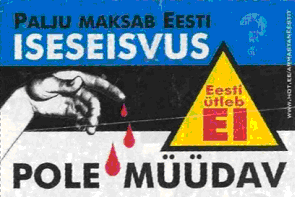K ulturwissenschaftliches Institut für Europaforschung
-
Kaidi Tago
(Lüneburg, Mai 2004)
The presentation of European identity in printed media
Images of Europe - construction of European media discourse in print media
In our presentation European identity is perceived as a process based on political, territorial and economical grounds. Process of identity formation encompasses both diacronical and syncronical aspects. Impression creation in printed media is a continuing process that is far too complicated to be analyzed as a whole in one short presentation. So we chose to use syncronical view in order to compare media approaches on the topic of European enlargement (1. of May 2004) both in German and in Estonian printed media. We used high quality newspapers (both Estonian and German) from the period of 2 months before enlargement to compare attitudes and evaluation of the process.
The question of power and influence arises here as a pivotal element. Who are the ones that determine the truth? For truth as we know is not a solid thing, but a socially constructed product and the most we could want from that notion, is that people sharing one cultural sphere shared the understanding of what is truth and what is not. There can never be such a thing as universally acknowledged truth. The attempts in the political world to create agreements and treaty's which would encompass most of the worlds 'civilazed' states has failed. Why? Because there can never be such democracy as we hope and dream of - states, as people, are never absolutely equal. There are always distinguishing factors to be found, be it wealth, military power or something else.
Reality is seen in our presentation as something constructed through establishing shared beliefs and values that become truths that are perceived as facts which are understood as reality. Establishing shared beliefs is possible through language which also means that truth, facts and reality are depend on language use. Different descriptive languages i.e. discourses provoke different reaction and form thus different realities.
When talking about European discourse we notice two major discources: dominant, official and oppositional. Official European discourse stems from the center of EU and is distributed through govermental institutions. It has qualities common to ideologies: simplified language use, message is reduced to essential issues. Attitude towards enlargement is strongly positive. Official discourse focuses on promoting unity between member states, creating unified beliefs etc.This discourse is dominant in all EU member countries and is more general, universal than oppositional discourse which depends more on regions and interest groups and is more national. So when positive talk on EU enlargement is similar in member-states, problems are perceived differently.
Examples of different ways of presenting EU enlargement: official (1) and oppositional approach (2).

(1) Dominant, colorfull, bright, positive, international (airport), well financed campaigne

(2) Oppositional, conservative, national, threatening and poorly financed campaigne. Enlargement does not have a central position in German media discourse but does so in Estonian print media. In German media primarily economic issues are discussed while in Estonia topics are more diverse and are discussed more emotionally. One of the biggest issues in Estonian printed media was the fear of loosing the national identity. It has never been a serious problem in Germany. This difference could be explained through the size difference between nations.
Our goal was to notice possible differences in identity creation. As a result of this paper we conclude that mechanisms of id creation are basically similar, differences eminate from different undrestandings of reality (which is dependent on language use). Problems for Estonians and for Germans connected with this enlargement have totally different scales: for estonians it's a big step in every aspect, for germans just something that might effect their economy.
___